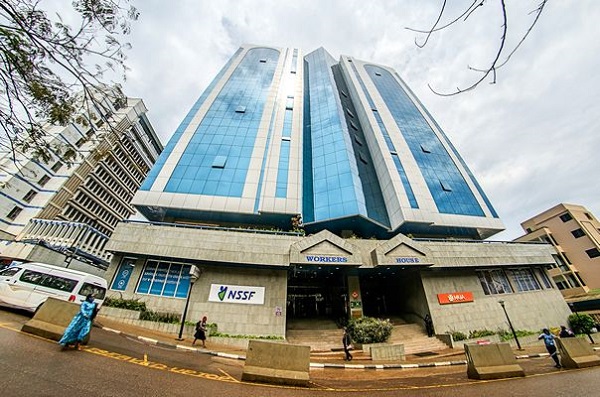
The long-term bond yields recorded a decline compared to the previous financial year, with the 10-year bond yield decreasing from 15.6% to 14.7%
Kampala, Uganda | JULIUS BUSINGE | Uganda’s National Social Security Fund (NSSF) has recorded a 15% increase in revenue, reaching Shs2.2 trillion for the Financial Year ending June 30, 2023.
Patrick Ayota, the managing director at the Fund, said during a media roundtable on Sep.18 that the key drivers behind the impressive financial performance include a substantial boost in interest income, which surged from Shs1.79 trillion to Shs2 trillion, and a noteworthy increase in dividend income, rising from Shs84 billion to Shs139 billion.
He said income generated from the Fund’s real estate projects also saw a slight uptick from Shs13.4 billion to Shs14 billion, with an additional Shs16 billion in other income during the same period under review.
“Overall, the investment environment in Uganda and the region was challenging over the last Financial Year. However, the Fund was able to increase its revenue owing to strategic asset allocation that enabled us to remain profitable, despite a generally depressed market,” he said.
Ayota said although inflation remained under control at 4.8%, the reduction in the value of the stock markets in Uganda and Kenya, the appreciation of the Uganda Shilling against the regional currencies, and the reduction in long-term bond yields increased pressure on the Fund’s performance.
“For us to post a 15% increase in revenue shows our resilience and an astute investment risk balance,” he added.
Long-term bond yields recorded a decline compared to the previous financial year, with the 10-year bond yield decreasing from 15.6% to 14.7%, the 15-year bond yield dropping from 16.1% to 15.2%, and the 20-year bond yield sliding from 17.6% to 15.3%.
In addition, stock markets in Uganda, Kenya, Tanzania, and Rwanda faced a lot of pressures such as stock market devaluation impacting the Fund’s performance.
The Uganda Securities Exchange Local Index reduced by 11.4%, the Nairobi Stock Exchange All Share Index reduced by 14%, the Tanzania Stock Exchange Share Index reduced by 4%, and the Rwanda Stock Exchange reduced by 2.2%.
There was a significant appreciation of the Uganda shilling against major currencies, mainly the Kenya Shilling which depreciated by 22.2% against the Uganda Shilling.
Ayota, however, said that the Fund’s financial position is stable and the Assets Under Management continue to grow.
The Fund’s Assets Under Management increased from Shs17.26 trillion in the Financial Year 2021/22 to Shs18.56 trillion in the Financial Year 2022/23.
This growth was driven by an increase in member contributions, increased realized income, and a cost management strategy that enables us to create more value for the member at a lower cost compared to the previous Financial Year.
With the current asset base, Ayota projected that the strategic goal of reaching Shs20 trillion in Assets Under Management by 2025 would be achieved by June 30, 2024, one year ahead of schedule.
Member contributions also saw a substantial uptick, rising by 12% from Shs1.2 trillion in the Financial Year 2021/22 to Shs1.5 trillion in the Financial Year 2022/23.
Simultaneously, the cost of administration reduced from 1.18% to 1.02%.
Ayota assured NSSF members that the Fund is in a better financial position going forward and the focus has now shifted to ensure its long-term sustainability.
“Our new “Vision 2035” is the bedrock of our long-term strategic focus– where we want to grow the Fund to Shs50 trillion, cover at least 50% of the working population, and achieve 95% and both customer satisfaction and staff engagement,” he said.


